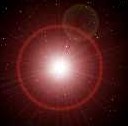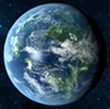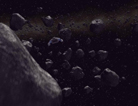NAN Exclusive: The breathtaking Sho System
by Sholari Vishana Vu-Shal
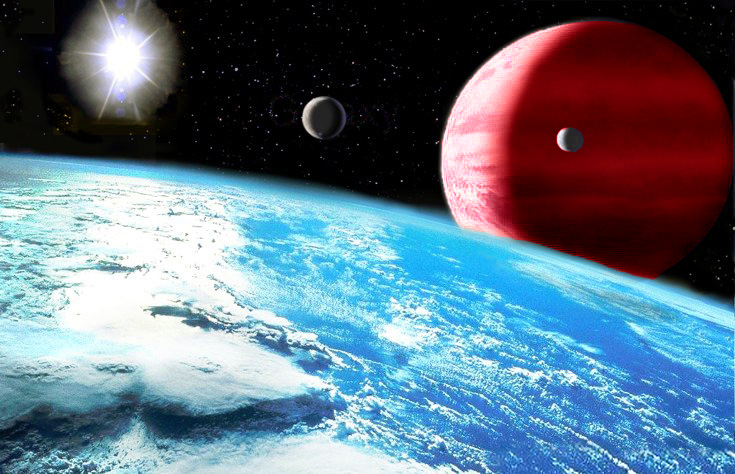 |
Our own system, referred to as the Sho ("Life") System is well know to the modern people of Sho-Caudal. But it was not always so. The ancestors of the Shan never knew of the stars and the existance of other galaxies. These were unseen to them and there was only the ebb and flow of the sho-sen and the moons they could clearly feel influence everything on Sho-Caudal. Later, the sholari of the Shan noticed and managed to measure the influence of Slin-sheesa (Sennos/Eden) and Mash-alihn (Sensemai/Elysium) upon the Sho-Caudal constellation. It was a shock to many a sholari to learn that Sho-Caudal and its moons were but a small part of the complex isho interchange between the planets [The Elysium Isho Bridge link]. Mash-alihn (Sensemai/Elysium) was the great isho storm that influenced everything and controlled Sho-Caudal's complex isho cycles.
With the coming of the other people the Shan learnt that there was life far, far away, but could still not grasp the distances which couldn't clearly be perceived. Distance had always been of less importance in the isho world of Sho-Caudal where time and cycles of change meant everything. That this life was infinately different from the Shan was no question, as they clearly and surprisingly had evolved without a life-providing isho field. Then, for countless shiima the abandoned people of Sho-Caudal lost the Way of Life and looked up in marvel at the night sky, not knowing what secrets they held. But the stars were not secret or unknown, merely forgotten. In the oldest legends and religions of all abandoned people were fragments of memories and shades of truth. Although the first visitors to Sho-Caudal brought doom and sorrow for themselves and the Shan, their knowledge of the Sho system was in the end added to the great pool of knowledge which is today shared by all free people. The very different ways to observe, measure and record the Sho system are today as diverse as the people themselves, but lead to infite detail, beyond the grasp of one mere isolated race. |
The most accurate observations of the Sho system are those made by the ancient human ancestors. They charted the Sho system - assumingly from afar - and when arriving from Earth completed their mapping. Detailed reports and mappings of the Sho System's planets, acquired by the unmanned probes of these ancients, were found already in 3489, but were little understood. Most of these facts were forgotten or lay forgotten again until nearly 300 years later. When Void exploration began in 3744, the traditional Tolamuun or ancient Terrans celestial names of the planets were often used, as there was such a wide variety of names throughout the cultures and races of Sho-Caudal. Although of unknown original cultural meaning, these ancient Terran names stuck and are used today as the official names of the planets of the Sho System. The ancient Terran measurement of Astronomical Units based on Earth's distance to its sun has also strangely stuck amongst the FSVC and IVA iscin. As a more figurative measurement to these cryptic measures, it can be worth to mention that a fast void vessel sails 0,2 AU in one day. Today, all the ancient Terran, ramian and thriddle records and terminology have been assimilated into the great database of the Sho System and remind us all that we are nothing more than infrequent visitors to these giants of the Void.
At the centre of our system lies the medium sized yellow star known to us as Te Sunn [A.k.a. Shey-eelish (shantic: "SkyFire"), Moro-Hoch (Rorch-ko: "The Centre"), H21 (Terran Terminology)]. Similar in size and gravity to Sol, the star that humanity once left, it is orbited by nine planets and two large asteroid belts.
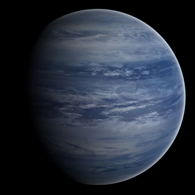 |
Te Sunn’s closest planet is a huge, dark blue gas giant named Stygia (Tolamuun: Varros). Stygia is nearly 20 times the size of Sho-Caudal's diameter, 400 times the mass and only 0.209 AU away from Te Sunn.
Great solar protuberances sometimes reach all the way to Stygia, reacting with its atmosphere. On some rare occasions (once or twice in a 200-year period) the atmosphere of Stygia ignites and burns brightly for a week or two. During this time Stygia can be seen clearly at night in the Sho-Caudal sky. Tolamuun priests named this phenomena – Destitta “Desti’s Child”, as the red, glaring star wanders between the moons.
Stygia has two natural satellites Juspa and Sarros which both are tidal locked on Stygia's nightside where they also are shielded from Te Sunn's violent sunstorms. During Stygia's flarings, Juspa and Sarros suffer a greta conflagration which had created fantastic and eerie rock melt formations on the hot and hzardous moons. |
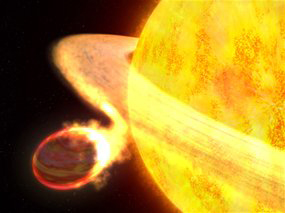 |
Beyond Stygia are two smaller terrestrial (stone/rock-based) planets called Lemuria and Eden.
Lemuria (Tolamuun: Tallos), the system's second planet, is a very large planet with such massive gravity that the people of Sho-Caudal have great problems surviving physically on its surface. Lemuria and its twelve moons are nearly tidal locked to Te Sunn making only one sidereal turn every sixty-fourth year. The planet therefore has one side in total darkness close to 40 years and another in devastating sunlight for 40 years. Two of Lemuria's moons seem to once have been one moon that was split by either collision or gravitational forces. Lemuria is a vast, desolate and barren wasteland, scorched by Te Sunn’s intensive glare. Terran probes found large iron deposits and old lava fields brimming with easily processed ore. The FSVC, the Void Hegemony and the IVA have unmanned automated mining stations on Lemuria. The crushing gravity and the continuous failure of such automated machinery has however littered Lemuria's dark side with abandoned mining stations. The planet still remains a primary source for new metallic resources. |
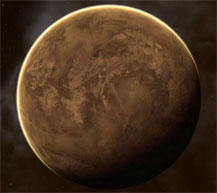 |
| Eden (Tolamuun: Sennos) is a very small, dusty world with low gravity and a chaotic atmosphere hosting tremendous wind speeds. The Terran expeditions to Eden noted nothing of value on this world except for large crystal deposits that seemed to charge the atmosphere with the same type of energy field that enveloped Sho-Caudal. Later Sho system explorers immediately saw the potential of Eden. Today we also know that Eden is part of the Elysium Isho Bridge (A.k.a. the Higher Alpha Isho Interchange or Sushano tro-lii). Although the sho-sen is weaker than on Sho-Caudal, the proximity to Te Sunn and its position in the Elysium Isho Bridge relationship makes it much more volatile and finer in structure, enabling it perforate any living tissue with devastating effects to isho harmonic cellular structures. |
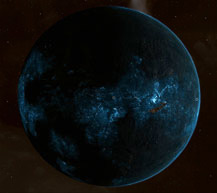
Nightside view of Eden's violent fine-strand isho storms |
The Void Hegemony early founded a small colony on Eden and the ramian seem unaffected by Eden's chaotic Sho-sen.
All other people need to be shielded from Eden's sho-sen, making colonization very hazardous. The IVA has a research colony and a military outpost on Eden and the only FSVC colony on Eden is called Shandane. This colony was nearly destroyed during the last Tri-Planetary Constellation in 3967 when Eden’s sho-sen underwent a strange transmutation. The horrors of the final days of the IVA military outpost is well known throughout the Sho system. Today, much research is made into Fine String Isho Mechanics and Tro-Shal Peripheral Energy. Apart from this and the mining of rare crystal composites, Eden offers no other resources.
Eden has no moons but a fair amount of small debris orbiting the world in a nearly invisible ring
|
Sho-caudal is the fourth planet of the Sho system and one out of two planets which contain life (possibly three). Together with its seven large moons, Sho-caudal forms the so called Sho-caudal Isho Constellation. Sho-Caudal is also part of the Elysium Isho Bridge and is an integral part of that complex planetary isho interchange. We today know that Sho-Caudal’s sho-sen and especially the background Alpha isho is totally dependent upon the unpredictable and still mysterious Elysium Isho Bridge fluctuations.
Sho-Caudal and its moons clearly baffled the iscin of Earth. In an astronomical sense, Earth is an unusual planet with its large moon. It is considered a twin planet system as the two bodies clearly influence each other to a significant degree. It seems quite rare to find a planet with such a large moon.
But when arriving to Sho-Caudal the Terran iscin found seven large moons. Two of these (Tra and Launtra) are slightly smaller than Earth’s moon, while four (Shal, Ebba, Gobey and Du) are larger. One of the moons (Desti) is enormous. The many moons create many solar and lunar eclipses and exert a great physical tidal pull on Sho-Caudal’s seas. This physical pull creates complex weather patterns and seismic activity. Especially the pull of Desti is known to be registered among most higher and lower animals.
But Sho-Caudal’s moons influence the sho-sen at a much greater degree than their gravity does. The complex and tidally changing isho charge of the moons rub against Sho-Caudal’s crystal generated isho field causing the ebbs and flows we Shan have studied since our ascent to sentiency. The complex isho relation affects everything on Sho-Caudal, plants and animals, crystalline lava flows, sho-sen and physical weather.
| The first terran iscin were totally blind to the isho and never understood its complex relation to everything on Sho-Caudal. It was not seen as a whole. For the Shan it is easy to “perceive” or “feel” how the isho flows between Sho-Caudal and the moons. It is natural for us to understand how the moons high above us interact with our world and creates the sho-sen as an effect of the energy that bounces back and focuses on the gravity well that is Sho-Caudal. But for the other people of Sho-Caudal this complex relationship can only be perceived through the latest sho implants. For more information: see The Mechanics of the Sho-Caudal isho ConstellationSho-Caudal has an axial tilt of 16 to 19 degrees (varying within a 56 000 year period) resulting in different seasons where average temperatures fluctuate between summer and winter. |

|
As a comparison Earth – the cradle of humanity - has an axial tilt of 21,1 to 24,5 degrees (currently 23,5 degrees) which theoretically should mean bigger seasonal differences with possibilities of glacial periods during the lower tilt periods.
Sho-Caudal orbits Te Sunn in 324 days and has a sidereal day of 27 old Imperial standard hours and 4 minutes (Shan: 7 seekva).
Humans have adapted to the slightly longer day by taking a nap during mid-day or late afternoon. As in the old days it is common for trade and commerce to endure past midnight. As another comparison, Sho-Caudal is slightly larger than Earth but has a fraction less gravitational pull because of its large quantities of crystalline substances instead of iron as on Earth. Because of this, a Terran-born human would be slightly stronger but shorter in average than a Sho-Caudal-born human. |
The moons of Sho-Caudal are as follows:
Desti, the largest of the moons, is as a comparison more than six the size of Earth’s moon. It is composed of red swirling gases and darker red cloud patches. A small and very dense core of solid matter lies deep within the gas moon which was reached successfully by FSVC probes in 3786. The atmospheric pressure is only slightly higher than on Sho-Caudal but the gravity strangely enough much higher. The surface consists mainly of chaotic molten crystal lava fields amidst howling red crystalline gases which are lethal to all known lifeforms. Desti’s gravitational pull effects Sho-Caudal in many ways such as tides and currents, but also seismic activity. It is clearly visible from Sho-Caudal (often clearly in daylight). For all species with tra-sense Desti is an ever present roiling mass of tugging isho – like an enormous dysha hanging over Sho-Caudal. All further exploration or harvesting of Desti’s natural resources is subjected to Sho-Caudal Warden approval in accordance with the Sacred Lunar Treaty of 3748.
Du is the second largest of the moons with a diameter three times as big as Earth’s moon. Du is covered with quickly swirling amber gas clouds. Unlike Desti, the clouds are only part of a thick, gaseous atmosphere and the moon has a much smaller solid surface underneath. However, the cloud cover is so thick that the surface of Du cannot be seen from Sho-Caudal. It looks like a small version of a gas giant with its smooth, amber cream surface. Du’s surface was extensively explored already in 3746 but nothing noteworthy apart from fields of old crystal lava deposits were found. Althoughthe atmosphere contains lethal crystalline gases, the Shan built a sealed temple on Du in 3872. All landings, settlements and harvesting of natural resources are subjected to Sho-Caudal Warden approval in accordance with the Sacred Lunar Treaty of 3748.
Ebba is nearly twice the size of Earth’s moon and has no atmosphere. It is filled with large craters, dark mountains, deep canyons and large, silver plains.Its appearance and details have sparked many myths
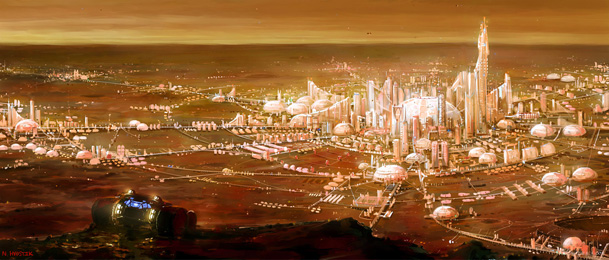
Kalasha colony on Ebba |
and is every night admired by the people of Sho-Caudal. An ancient terran research station was discovered on Ebba in 3744, at the exact location stated by Tolamuun astrologers. From the Lunar Field Station Terran iscin could safely study Sho-Caudal and its inhabitants. Only after the Shan had agreed that the iscin were allowed to live on the surface was the main bulk of the outpost moved down to the planet. The original science outpost always remained manned, along with its additions (long-range communication arrays and Inter System Vessel Trackers). Terran iscin studied the vast crystal fields of the moon, and were close to a breakthrough, regarding the strange but seemingly harmless energy field surrounding Sho-Caudal and its moons. The last operational personnel abandoned the communications and tracking installations in haste when the Sho-Caudal colony was attacked by the Shan. Deserted machines and buildings still stand, untouched and preserved over the millennia.
The Lunar Field Station is a pristine but sad testament to humanity’s greatness and is today a grand museum, despite the damages the Iron Empire caused it during its occupation in the Second Iron Curtain Conflict. Most of the ancient Terran astronomical data we have today originates from the ancient and carefully restored tenktons of the Lunar Field Station.
The large plains of Ebba are composed of crystal lava that was once pushed up to the surface of the now cold moon. The plains are filled with crystals of all sizes and shapes that reflect the light from H21. Before the discovery and mining of Elysium’s moons, Ebba was the primary off-planet source of industrial crystals. Mining ceased in 3785 and the moon is today a protected reserve monitored by the Sho-Caudal Wardens. Large domed colonies dotter Ebba's surface, run by the various Free States, the Void Hegemony and the IVA. More than 2.500 0000 colonists inhabit Ebba today |
Gobey is slightly larger than Earth’s moon, but has a dark surface that reflects little light. Only its outline is seen on the night sky and its presence is felt through the dark, star-less patch in the night sky. Gobey has no atmosphere. Already terran iscin noted that Gobey’s core still was molten and active. On very rare occasions volcanoes erupt on Gobey and can be seen by the naked eye as small red dots. The ancient Tolamuun astrologers referred to these as Gobey’s Wrath. Earthquakes are common on Gobey as well as other isho phenomena such as isho storms and powerful isho surges. Unseen from Sho-Caudal, Gobey is filled with skyrealms of all sizes, which rise and drop chaotically when passing inside the other moons, especially Desti. A sealed Shan temple was built in Gobey’s seismically more stable south polar region in 3767. All landings, settlements and harvesting of natural resources are subjected to Sho-Caudal Warden approval in accordance with the Sacred Lunar Treaty of 3748.
Shal is an elegant and pristine moon with no atmosphere and is roughly the same size as Earth’s moon. It has some scarring and craters, but is relatively smooth in comparison to Ebba. Among the larger cracks of Shal’s surface iscin have found large crystal deposits extending far down into the centre of the moon. Iscin have come to the amazing conclusion that the moon is composed of more than 30% crystalline matter. Shal has a strong sho-sen of its own but is chaotically subjected to the influence of the greater moons, such as Desti. Like Eden, this makes the sho-sen very dangerous for the people of Sho-Caudal, although not as alien. Shan are known to have mastered the sho-sen and can – after extensive training – establish an isho equilibrium and survive there. Despite its richness in crystals, Shal has never been industrially mined by any nation (apart from the unlawful Imperial mining ship occupation during the Second Iron Curtain Conflict). A sealed Shan temple outpost was established on Shal in 3771 and a Void Hegemony research station is situated on Shal’s equator since 3822. All landings, settlements and harvesting of natural resources are subjected to Sho-Caudal Warden approval in accordance with the Sacred Lunar Treaty of 3748.
Launtra is slightly smaller than Earth’s moon. Its surface is very bright and reflects a great amount of light of the light green spectrum. It is the strongest shining moon orbiting Sho-Caudal. The moon is void of atmosphere and has many craters and ridges visible from the planet. Launtra is dotted with FSVC, Void Hegemony and IVA research stations but no formal colonies. All landings, settlements and harvesting of natural resources are subjected to Sho-Caudal Warden approval in accordance with the Sacred Lunar Treaty of 3748.
Tra is only two-thirds the size of Earth’s moon. Compared to Desti and Du, it is a very small moon on the night sky. A white and grey cloud layer covers Tra but brownish patches can also be seen in the otherwise bright cloud layer. At times these darker patches seem to grow steadily, disperse, and then disappear. On some rare occasions Tra’s dark brown surface can be seen as the clouds open up for a few days. The Shan have always regarded Tra to be special and many humans swear that the future can be predicted by studying Tra’s ever-changing clouds. Historic plagues, wars and other disasters have reputedly happened when Tra has had an enormous increase in dark clouds, which nearly entirely covered its surface. The aeon old wars that were fought between the Shan sects in ancient times were said to cause Tra to hide its face in darkness for hundreds of years. Tra has always held a special position among caji as being the collective isho force that is composed of all colours. It is related to cashiln walking and the creation of cle-eshtas. Early terran iscin noted a few volcanoes and a toxic atmosphere that had the potential for bacterial life. It is these volcanoes that spew out smoke which frequently cover the moon in darker clouds. Tra, its weak but enigmatic sho-sen and the curious rumours of ruins was studied already by a small group of terran iscin. However, the secrets they might have uncovered were never revealed before the colony was destroyed. Later research in our modern age have uncovered many strange facts and anomalies of Tra’s sho-sen but never any ruins. Bacteria have been found amongst the hotter clouds surrounding the volcanoes. But no advanced lifeforms. Because of its religious importance, Tra is the moon most viciously protected by the Sho-Caudal Wardens. A sealed Shan temple and a FSVC research station was built on Tra in 3751 landings, settlements and harvesting of natural resources are subjected to Sho-Caudal Warden approval in accordance with the Sacred Lunar Treaty of 3748.
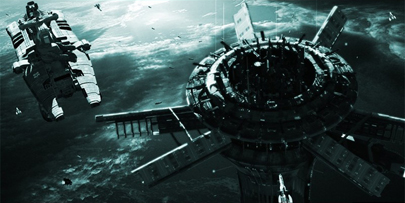 |
In orbit around Sho-Caudal and its moons are now more than 49 orbital void stations, half of these linked to Sho-Caudal via orbital cashiln portals. 5 are FSVC, Hegemony and IVA void vessel maintenance and construction yards. 23 are research stations. 10 are military installations of the Free States, the Hegemony and the IVA. 11 are in-system transit hubs, transporting personnel and resources to and from the void colonies of the Sho system. The largest of these is the old Sho-Tashka Void Station. Stemming from the earliest day of FSVC void exploration,the void station has grown to a tremendous size. The newer Cerashu Void Station is known as the docking base of the FSS Mayatrish. It will be the official launch point of the Origins Expedition.
Sho-Tashka Void Station
|
The system’s second gas giant, Elysium (Tolamuun: Sensemai), lies beyond Sho-Caudal. It is a magnificent and pristine planet eleven times Sho-Caudal’s diameter and 310 times its mass. Elysium has gold and green clouds spread evenly over its immense surface. The planet has four large rings of varying colours, gold and blue being predominant. The rings slowly shift colour and shape to become oval and purple at times when the planet aligns with Sho-Caudal and Eden. During so called direct alignments, the Isho bridges become super charged with low resonance Alpha isho.
Terran iscin did not seem to have spent much time studying Elysium or its rings when they first arrived. However, only a year before the colony was destroyed, a team of terran iscin noted an identical energy field to that of Sho-Caudal which permeated Elysium. The report of these iscin contained a theory that the three planets Elysium, Sho-Caudal and Eden were of the same matter.
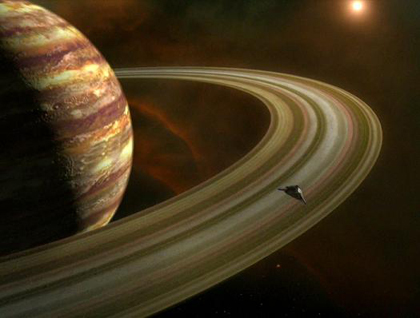
Elysium and its rings |
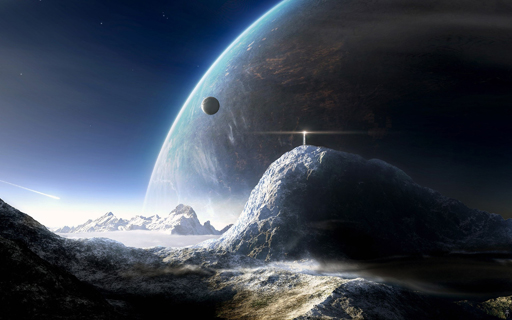
Elysium seen from the Dovaccan Mountains. (Vashilta Ca-matra temple in foreground) |
Today we know that Elysium is the most powerful part of the so called Elysium Isho Bridges which connect the three planets Elysium, Sho-Caudal and Eden. Elysium’s super charged sho-sen, brimming with volatile Tro-Shal isho, is actually pumping the other crystalline planets with isho along these bridges. The same main crystalline elements are found on Eden, Sho-Caudal and Elysium as well as most of their moons. On Elysium itself, the crystalline matter has been reduced to gas form due to the extreme gravity. The complex bridge interchange of these crystal gravity wells are charged when the planets and moons “rub” against each other.
Several probes and industrial gas collection stations have over the last century dared the stormy atmosphere of Elysium with its deadly Tro-Shal discharges. Elysium was regarded as a hostile and deadly place. But in 3842, new deep dive probes returned with evidence of floating lifeforms, deep down in the warmer and crushing cloud layers of Elysium. These are today referred to as Simirrian floaters and are totally alien to the shantic lifeforms evolved on Sho-Caudal. Since then manned expeditions have dared the crushing isho chaos of Elysium to study these gigantic lifeforms. So far it is evident that the Simirrian lifeforms are extremely deadly to the people of Sho-Caudal, with natural nerve toxins, insanely dangerous natural isho defences and natural isho weaponry. A whole new biotechnology industry is evolving around the study of the lethal simirrians.
Elysium and Stygia protect the planets between them with their strong gravitational pull by acting as vacuum cleaners and attracting all kinds of cosmic debris that could have impacted on the planets as meteorites. Elysium can be easily seen from Sho-Caudal and is, together with Stygia, Lemuria and Eden the most noticeable of the Sho system’s planets.
Seventeen moons circle Elysium. Ten of these are very small and barren crystalline rocks. Some are not even of crystalline nature and have most likely been captured by Elysium in the distant past. Four of the moons have a lot of thermal activity and volcanoes glare on their surfaces as Elysium pulls their molten cores towards it. Three of the moons have reasonably stable surfaces and their own atmosphere, which consists mainly of noxious gases flowing or boiling over icy surfaces. Tharsis, the greatest of the moons has a thin atmosphere covering chaotic volcanic plains separated by high jagged mountains. Clinging to the four of these mountains are the Tharsis colonies, research stations and mining outposts of the FSVC, The Void Hegemony, the Shan and the IVA. Despite the strong Tro-Shal isho of Elysium, the colonies and the colonists seem largely unnafected. Tro-Shal isho simply isn’t harmless to the people of Sho-Caudal and the super charged isho bridges connecting to Eden and Sho-Caudal form/begin funneling far beyond the rings and moons of Elysium.
Jacta is the second largest moon which hosts mining outposts, small colonies and research stations of the FSVC, the Void Hegemony and the IVA along the ice clustered north and south poles.
Sentra is the name of a small rock moon which isn’t composed of the same crystalline matter as Elysium. A FSVC research station and several small roving mining stations can be found on its powdery surface.
Six void stations orbit Elysium for military, transport and scientific purposes.
Approximately 3.800 000 colonists inhabit Tharsis, Jacta and Sentra.
| Beyond Elysium lies the small planet Atlantis (Tolamuun: Hiira). It was given its name by the Terran iscin who found an ice-covered ocean bombarded by all kinds of meteorites from the nearby Brent Asteroid Belt. The craters and cracks of Atlantis icy surface are easily seen from orbit. Warmer and darker water from below has flowed to the surface after meteor impacts and frozen. This has given Atlantis many darker stains on its pale surface. Some probes have penetrated the kilometre thick layer of ice and investigated the dark ocean below. It has the potential for microscopic life close to its submerged volcanoes, but no evidence has ever been found. It was on Atlantis that the signs of the cleash end. Two abandoned or crashed ships, a small mining operation and several dead cleash and scarmis in organic cocoon-like void suits were all the cleash left behind. Where the cleash went is reason for much debate and conspiracy theories. Rumours circle the world weave of cleash colonies in the black depth of Atlantis' oceans, but so far nothing has been found. Some small water and mineral mining stations – most unmanned – can be found on Atlantis. Atlantis has two barren moons - Sortah and Crysia. |
Atlantis' frozen surface 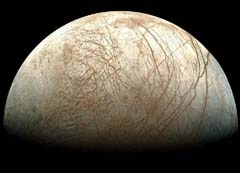 |
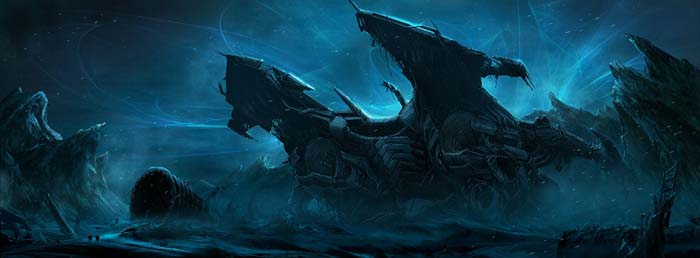 |
Crashed Cleash ship on Atlantis
with solar ionisation storm in background |
The immense Brent Asteroid Field (Tolamuun: Keeper’s Hand) lies beyond Atlantis. Several manned mining stations of the Free States, the Void Hegemonyand the IVA operate in asteroid field.
Already during Terran exploration of the Sho System, the Brent Asteroid field was targeted as the main supply of easily accessible ore in the system to be used to sustain the colony on Sho-Caudal. |
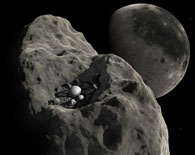 |
Two experimental URMS (Unmanned Roving Mining Stations) were tested in the asteroid field. These were abandoned to their fate when the colony was attacked by the Shan. The URMS continued to operate for a couple of hundred years until they had been damaged beyond self-repair by smaller debris of the asteroid field. One URMS has been towed to Tharsis for display, while the other remains anchored to a large asteroid named The Mandare. |
Beyond the Brent Asteroid Field lie the two outermost terrestrial planets Asgard and Bifrost.
Asgard (Tolamuun: Tuura) is more than four times larger than Sho-Caudal and is orbited by six moons. Meteorites from the Brent Asteroid Field and Scylla’s necklace bombard Asgard endlessly. Many craters can be seen on its dusty and lifeless surface. Darker, deeper lying dust is seen at the centre of the craters, giving Asgard a spotted appearance. The largest crater, the Samorril’s Crater, has torn a mighty hole into the planet’s surface and is the most noticeable detail of the planet. The crater is three kilometres deep and 2000 kilometres in diameter. The light brown hue of the planet reflects a lot of Te Sunn’s light and those who know where to look can easily find the planet in Sho-caudal’s night sky. From orbit, Asgard shines with a golden hue. The light brown hue and the darker spots at the centre of the craters gave the first explorers the impression of golden wood. The immense gravity of Asgard prevents any human from ever setting foot on the planet. Unmanned probes have found nothing special of value on the planet to attempt any further exploration. |
Asgard 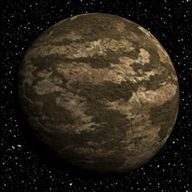 |
| Bifrost (Not known by Tolamuun astrologers) is a small block of ice with a stony interior, orbited by two barren moons. Its frozen water and gases gives the small planet the appearance of a great frozen sea with rocky mountain tops sticking out of the ice like a great planet covering archipelago. Like Asgard, it is bombarded with meteorites. Bifrost’s craggy, icy surface reflects little light and the planet was never detected by Tolamuun astrologers. Terran probes explored Bifrost very late as the iscin didn’t discover its existence until after arrival to the Sho system. Bifrost has nothing really of value apart from an abundance of ice which is used to create water and air for the FSVC and Void Hegemony observatories in Scylla’s necklace. A Void Hegemony colony can be found on Bifrost but it remains an enigma why the Void Mariners would choose to settle there. |
Bifrost 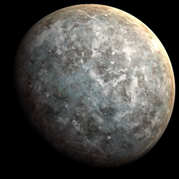 |
Another asteroid belt lies outside Bifrost. It is called Scylla’s Necklace, as it is influenced by the strange proto-planet anomaly Scylla. It is not as large as the Brent Asteroid Field but its outer edge is more ragged and torn due to the gravitational pull of Scylla that circles close to it. A lot of meteorites crashing through the system originate from Scylla’s Necklace and are flung outward and inward from the belt when Scylla tears at it. On two moon sized asteroids amidst the chaotic rubble of the asteroid field are the Helkos and Schrakmaar Observatories. One operated by the FSVC and the other by the Void Hegemony. Their main purpose is to monitor and conduct research into the enigmatic Scylla anomaly. A posting in Scylla’s Necklace is depressing, dark and cold and close to intolerable for all but the ramian Void Mariners.
The outermost body of the system, Scylla, is a strange space anomaly and a great peril to space exploration in the outer parts of the system. It consists of a cold, slushy, slow whirling gas proto-planet with an enormous gravitational pull. Scylla's name is most likely derived from an unknown ancient Terran general or even a God and it attracts a lot of asteroids and planetoids from Scyllas Necklace and the system’s icy Void Fence. The extended arms of debris circle around Scylla, giving it an appearance of a slowly whirling maelstrom or a small galaxy. The affected area around Scylla is very large and the first probes investigating the anomaly couldn’t escape the gravitational pull and were destroyed. . Iscin theorise that a great gas planet somehow has collapsed into some kind of dense matter that might one day develop into a black hole and destroy the Sho system.
Other theories suggest that Scylla is actually the first stage of a super gas giant that is building up mass. How such a small black hole can exist or why one single planet would be so much younger than any of the Sho system’s other planets is unknown. Ramian Void Gorochka (astrologer-priest-iscin) are very troubled by Scylla and spend much time studying it. Otherwise accurate ancient lamorri depictions show ten planets within the Sho system, which have led Hegemony astronomers to speculate whether Scylla is the remains of this tenth planet. If this is the case, Scylla has collapsed extremely recently in astronomical terms measured. |
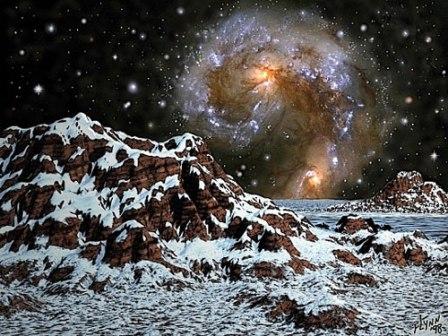
Scylla seen from Bifrost |
Beyond Scylla [At roughly 50 Au from Te Sunn] begins the Void Fence, a vast ring of ice and rock, its mass greater more than twenty times the planets and asteroids of the inner Sho system. Only three FSVC deep Void vessels have ventured out into the Void Fence. Void Mariners hare however renowned for their exploration of the icy giants of the Void Fence. The Void Hegemony even have an unmanned Void Way Station somewhere deep within the Void Fence.
The great influence of Te Sunn’s mighty solar wind ends far beyond the Void Fence. A great bubble-skin of rocky debris left over from the Sho system’s creation lies more than 800 AU away. This is the
Parameter Cloud and beyond it lies the Deeper Void of nothingness. The ramian Void Mariners call it the eternal Black Sea and boast to have sailed it. Just beyond the Parameter Cloud lies the Void Hegemony Observatory known as Marrkra. A return trip to Marrkra takes close to one year with conventional STL drives, which is why only ramian Void Mariners would even consider the trip in the first place. The existence of Marrkra was not known until 3887 when Void Mariners stationed on Marrkra detected the TSS Burundi derelict drifting out into the Deeper Void. |


